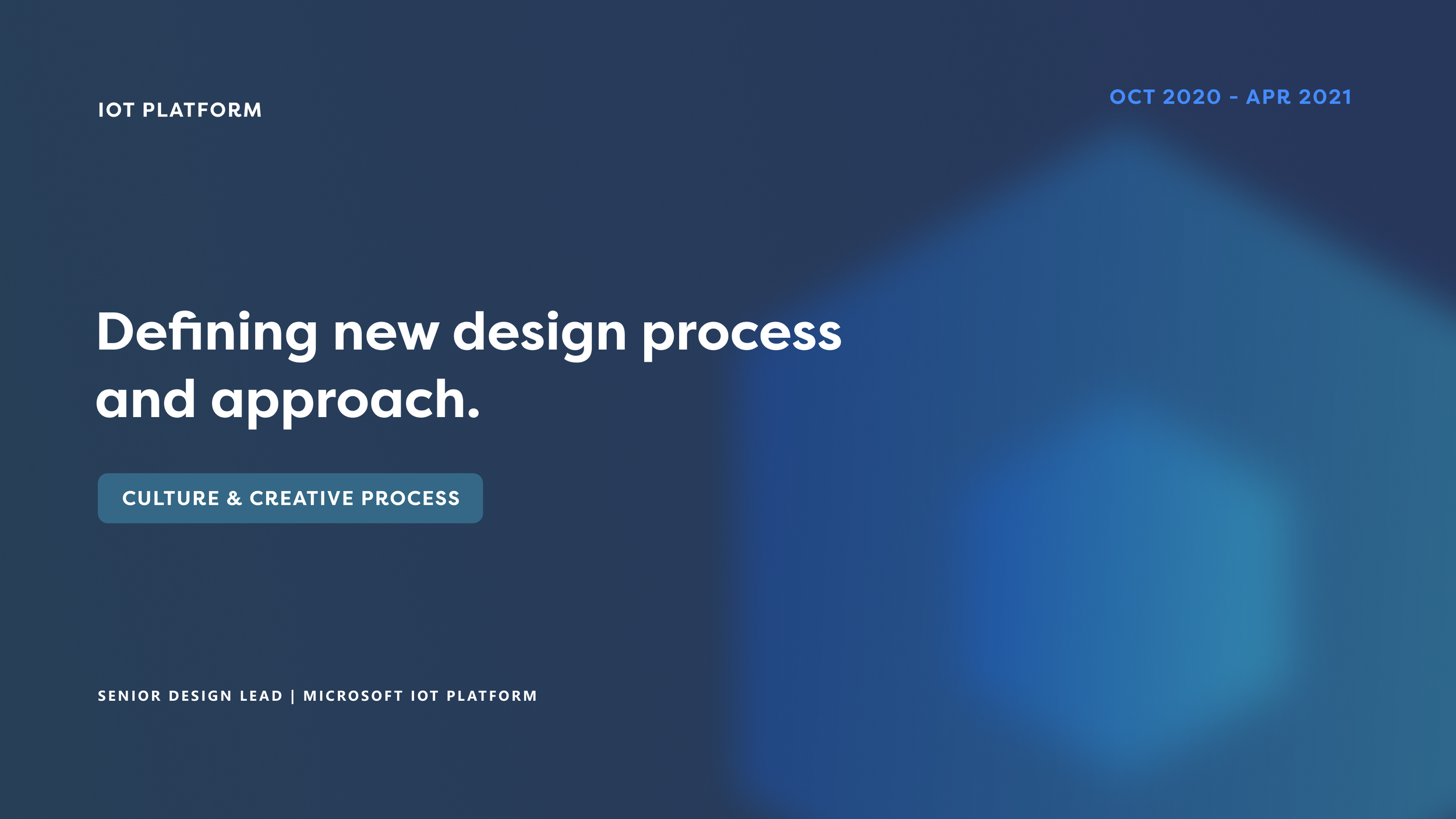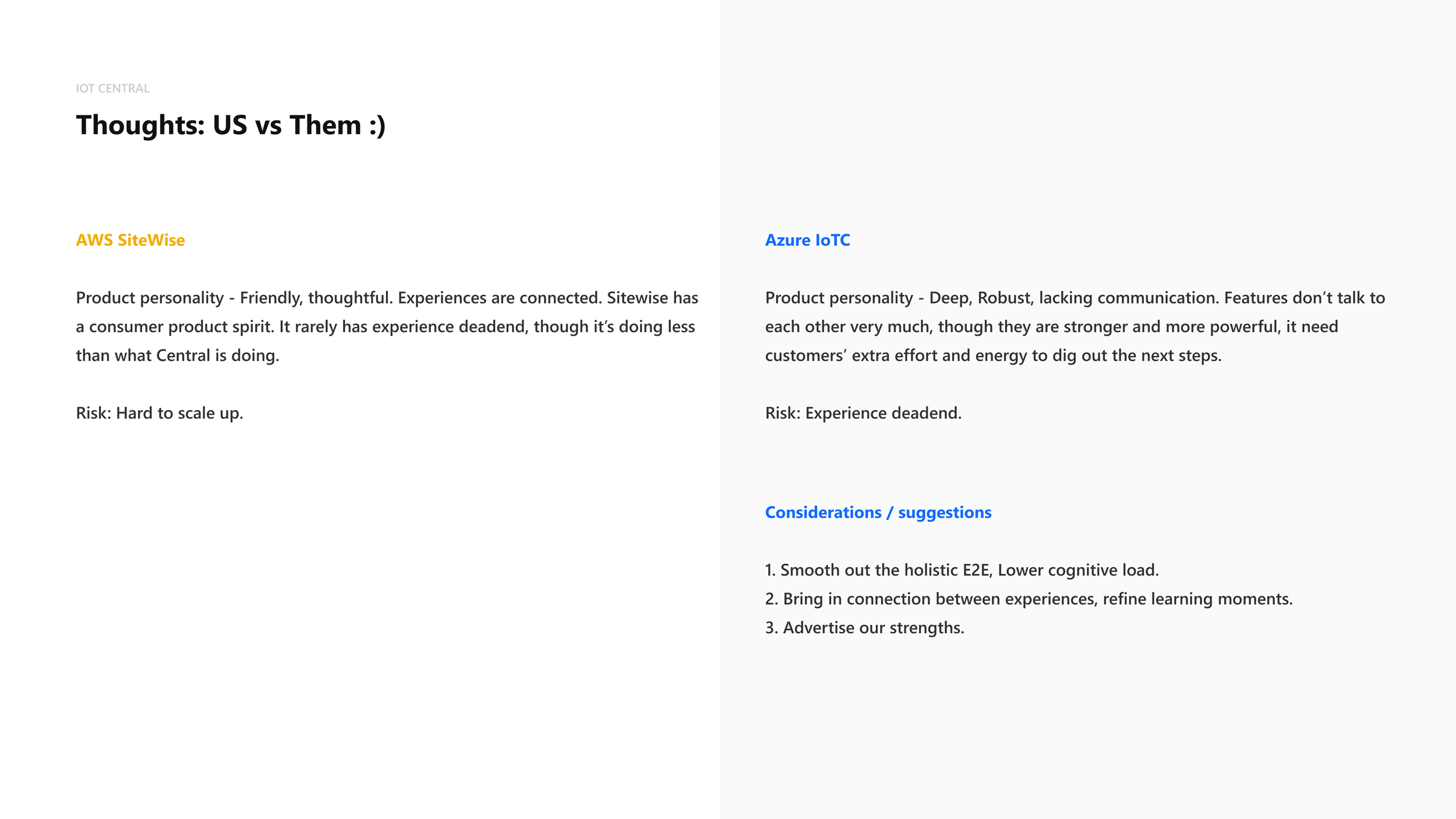
Culture and process

BACKGROUND, FACTS, AND OPPORTUNITIES
I joined the Azure IoT platform in Late 2020, the product I was on is called IoT Central. The product helps IoT solution builders connect and manage thousands to millions of IoT devices at scale leveraging over 30 Azure services. Unlike the Mixed Reality teams that have the design / vision-led culture, the IoT Platform was operated in a very traditional way “Max Execution with Zero vision” that designers usually are involved at the last minute to create screens. And there is a cost! The product was very disconnected and hard to use. The product had a hard time scaling up to a large customer base accordingly.

In this project, you will see a highlight of the major efforts I’ve made to change culture, build strategic partnerships, and introduce the design process to the team as a senior design lead.

With this approach, we massively reduced churn and increased collaboration. Designers were involved in the process earlier and delivered connected and compelling experiences. We built a better product for our customers with lower costs, a supportive culture, and team pride!
Part 1. Introducing new design processes through a case study
Business Impact
Developed a two-year vision on a key feature area that fundamentally changed the way teams executed based on a reproducible blueprint that was generalized from the above design work.
Cultural Impact
Enabled the engineering team to move from a reactive approach to feature prioritization/design to a more strategic approach by leveraging a lightweight, design-led, highly collaborative approach.
Case Study:
Below is a case study I did with a feature crew on the IoT Central team, introducing the design process to help create the relevant, compelling experiences of the IoT Central data export experience. The goal of this feature is to increase adoption for IoT Central extending data export via data transformations, and this is one of the most essential and technical areas within IoT Central. We were involved in design and research early, did prototypes, and created a north star vision while delivering a scalable first click stop.
The case study has 3 sessions: Design the right thing. Design the thing right. Think ahead.
Section a. Design the right thing. In this section, we found the right problem to solve by leveraging a series of design tools/processes to increase customer/tech empathy.
Section B. Design the thing right. After finding the right problem to solve, we focused on filling in the gaps of the E2E flow through Low-fi prototypes, interactive prototypes, and finalizing the design with a high-fidelity approach by leveraging the Fluent design system.
Section C. Think Ahead. With all the learnings and insights we got from the previous approach, we moved towards envisioning the north star with confidence.


Part 2. Generalizing the approach across teams
Cultural Impact
Greatly reduced churn and enabled highly cross-discipline collaboration. The team is more open-minded and understood how to involve designers earlier in the process. The team was more encouraged to think about how to make the product better from the bottom-up, instead of just the top-down.
Business Impact
The user-centered design brought in more innovation and empowered the team to engage with customers and validate hypotheses earlier with an iterative mindset. This helped reduce engineer cost and increased the ROI.
Part 3. Increased understanding of the competitive landscape
Impact:
-Key insights that drove a new information architecture, the redesign of multiple key features, and increased understanding of the competitive landscape by all disciplines within the product team based on competitive research and analysis.
-Understood the product variances in target markets to strengthen the product identity and build differentiation.
Approaches:
IoTC design team did a workshop to try out our competitor app -AWS SiteWise. Here is a collection of the highlights on experience comparison, thoughts, and ideas. We grouped them into 9 feature categories for easy consumption and referred to the MSFT UX Tenets and Traps usability analysis tools. The entire study was about 50 pages, below are some example pages that I am allowed to share under NDA.

Part 4. Empower ideation with a LO-FI toolkit
I built this toolkit to make ideation easier, faster, and more collaborative. The lo-fi design toolkit was broadly adopted by IoT design & PMs and also attracted a broad audience from peer organizations.
Business Impact:
The toolkit helped people to focus on the core problems to solve, instead of being distracted by specific UI components. It supported an iterative process & mindset for the product team that greatly increased feature ROI and reduced churn!
Culture Impact:
The lo-fi toolkit made designers and PMs feel proud of their work! People could assemble a beautiful ideation concept in a minute! There was a surge of brainstorm meetings on the team!
Part 5. Feature videos
Feature video is an opportunity to celebrate the contributions of everyone on the team!
By introducing and producing 2 feature videos on the team:
W generated positive energy, pride, and momentum where everyone feels invested in the success of the product.
W created a broad alignment on the intent of the work and functionality available to efficiently build consensus, awareness, and reduce churn. Some of the additional overhead created by working remotely can be eliminated by easily sharing these high-quality artifacts across the team.
We built an emotional connection to our customers to increase understanding & empathy. Shared externally to get early customer input.
Summary:
By doing the case study, we modeled the way of delivering high-quality connected experiences and generated excitement & passion for the team.
By generalizing the approach with relatable tips & examples, we made the changes easy to adopt.
By increasing our product understanding in the competitor landscape, we understood the differences in customers, target markets & scenarios. We moved forward and strengthened the product identity and built powerful differentiation.
By creating the lo-fi toolkit, we made ideation easier, faster, and more collaborative! This put the problem we were trying to solve into focus and made people proud of their contribution.
By creating feature videos, we celebrated team success and generated team pride!

Learnings
Bringing in culture & process changes is not much different from delivering a compelling and relevant product to customers. When we implement passion, care, and empathy, we produce the best possible result for the product, team, and people.
Understanding the team history - every culture & process has two faces. Learn about the compromises and opportunities when decisions were made in the past. Articulate the root problem to solve, appreciate the success the team had.
Model the way, let people see the outcome, and feel the difference! Provide applicable guidance for easy adoption.
If you are interested in chatting more about the details, please reach out :)




























